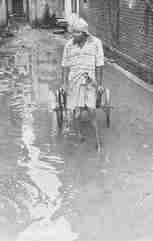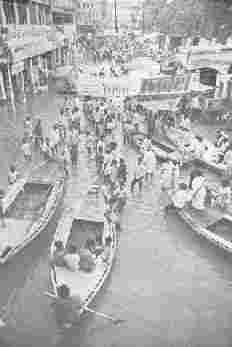Holy Ganga Turned into a Sewer

For twenty-five days in October 1994, sewage stood waist-deep in schoolteacher Urmila Dwivedi's lane in the Nababga neighbourhood of Varanasi. She described the scene: "We could not move. Our children could not go to school. Shopkeepers could not go to their shops. Their livelihood was threatened. It was terrible. It was dangerous to our family's health. There was not only sewage in the lane," Urmila points to a stain on the wall of the living room of her house, "our entire ground floor was inundated with sewage. We had to move upstairs. Water is one thing. We are accustomed to the floods. Every year they come. But sewage! That is too much. A rickshaw driver's feet would be in sewage if he allowed them to follow the pedals of his bicycle around the lower end of the pedaling cycle. Stinking sewage. Dangerous sewage. Children walk in it. Men and women try hard, but fail in their efforts to avoid walking in it. Finally some of my women friends and colleagues and I decided that we had to do something." The women decided they would stop the traffic on one of the main roads of the city. "What else could we do?"
Two hundred women occupied a major inter-section in the city for two days. Traffic was tied up. The women protested and sang songs. They spoke to each other and to anyone else who would listen. Finally they went to the office of Mr Hamad, the head of the sewage treatment department. With the force and moral authority of their unity they "invited" him to accompany them to their neighborhood. For two hours they forced him to stand waist-deep in the sewage in their lane. Mr Hamad, a tight-lipped, proper man, was humiliated. He had been so proud of his important position with Uttar Pradesh (UP) Jal Nigam, the semi-autonomous organization which has responsibility for sewage transport and treatment. As general manager of the Ganga Pollution Control Unit as well as the supervising engineer of UP Jal Nigam, Hamad was then not only deep in sewage but also in denial of the impact of the engineering decisions he and his unit had made. It is not known whether he knew of the effect of his treatment plant and pumping station on the lives of the people of Varanasi. If he didn't, he should have.
One thing is known. Before the Ganga Action Plan (GAP) came into effect five years ago the people in Nababaga did not have such problems in their area. There were other neighborhoods in Varanasi where sewage backed up in toilets regularly, especially when it rained. Whatever the GAP "fixed" created breaks in the sewage system elsewhere as evidenced by the sewage standing in Urmila's lane. The people of Kamauli, a village which was built by the GAP near the Dinapur sewage treatment plant, have wells that are contaminated.
Although it has brought water to their fields in the form of deadly effluent the Kamauli villagers are not happy with the GAP.

|
Sewers that are adequate for day to day sewage may become filled beyond capacity when the rains come. In most cities of the world, storm water is collected into the sewers where it mixes with sewage and proceeds to overwhelm the capacity of the sewage treatment plant. In such situations, a decision is usually made to simply bypass treatment and send all the untreated waste water into the river or ocean which ordinarily receives treated effluent.
The alternative to the release of a large volume of raw sewage during the rainy season is very expensive, involving construction of parallel storm sewers which only carry storm water. The ancient sewers of Varanasi are not only inadequate to carry the huge load of storm water, but when the sewers become too full, the pressure causes the sewers to collapse and streets to cave in. Houses, cars and people are all affected by this mess; indeed, several houses collapsed due to sewer cave-in during 1994. Now the World Bank has funded an expansion of the water system in the city. It is ludicrous to allow almost double the amount of water to flow into the sewage system without increasing the waste capacity of the sewers.
The city of Varanasi slopes gently toward the river. Two main sewers run under the roads that run north and south, parallel to the river, but many people live between the first sewer and the river. In 1972, large pumps were installed with World Bank money to pump the sewage from these densely packed buildings. The pumps are housed in pink structures. These pumps were designed to send the sewage back up to the road where it could join the main sewer. For seven years these pumps did not work. Every day men went to work at the five pumping stations, played cards, drank a little tea and came home from "a hard day at the office". The pumps stood idle. After investigation by the Sankat Mochan Foundation, a small but technically competent non-governmental organization whose aim is to clean Ganga at Varanasi, it came to light that these pumps had never worked. It wasn't hard to tell that they weren't working. Pumps make considerable noise. These pink monsters rested mute while the World Bank collected interest on the money given to build the pumps. No accountability mechanism was created to ensure that the pumps were working.
After considerable pressure was put on the UP Jal Nigam staff, they got the pumps going. With GAP money each pump was updated and another was constructed. One would think that there would be no leaks of sewage at the river front after the expenditure of so much money. Unfortunately this is not true.
There is less sewage flowing directly into Ganga in the non-monsoon months, when electricity for the pumps is available. The pumps are shut down for five months during the monsoon because silt would flow into the pumps and damage them. Too much water would overwhelm the pumps. The Sankat Mochan Foundation started to lose faith in the pumps as a year-round solution to the problems of pollution and adopted the slogan "A Seven Month Solution to Pollution is No Solution". All too often the electricity department turns off the electricity in the morning usually between 7 a.m. and 10 a.m. just when the peak load of human excrement hits the sewers. When this happens, the sewage falls directly into Ganga at the very places where most people are bathing.
Unfortunately these pumps are not the only problem causing the sewage standing in Urmila's lane. To understand more about that mystery, we have to know a little more about sewers themselves.

|
A sewer is a tube through which waste water and specifically sewage flows. Sewage is household waste, while waste water is a more general term including industrial waste. Storm water is rain water and debris (leaves, oil, pesticides, dust) gathered by the rain water as it moves toward the sewer.
A sewer is usually round with the bottom known as the invert and the top known as the crown. A sewer should have sufficient capacity at the crown for air. A full sewer is a sewer that is going to back up either at the manholes or in the homes and toilets of the city. The sewage has to go somewhere, so if it is allowed to flow freely, it goes to the lowest point and exits through an outlet. Otherwise it backs up. It is very important to have a free fall of sewage into a large tank where the sewer ends. If this tank is too small for the free fall of sewage, the water in the tank acts as a dam and blocks more waste water from coming in. Again that dam causes a backing up, or in sewage talk "heading up" of sewage at you guessed the lowest spot where it can escape. In the case of Varanasi, that is the neighborhood in which Urmila lives.
All sewage comes to the Konia pumping station. Initially it falls into a holding tank and from there to another tank which has three enormous screws resting in the tank. These screws are turned by electricity and they raise the sewage up so it can fall through screens which remove solids like plastic bags, rocks and sticks. Then sewage is pumped through gradually sloped pipes (called rising mains) toward Dinapur sewage treatment plant. The sewage often moves so slowly through the main sewer that it cannot relieve the pressure from sewage behind it. The sewage then falls into a tank. It is the depth of this tank and the depth of the tank at the base of the giant screw pumps that causes many of the problems.
Engineers who worked at the construction site said that the tanks were designed to be much deeper tanks, however, during construction underground water was struck. It costs a great deal more to build a tank at such a place than on dry land.
Someone did not have the foresight to think of the possibility that water would be so close to the ground's surface where the tank was to be built. The cost for underwater construction for a sufficiently deep tank was not budgeted. So the decision was made we are not sure by whom to simply build the floor of the tank right to where the water was and then to stop.
It was probably quite an innocuous decision. Surely it did not seem to be a decision of life and death significance. Indeed it must have appeared to be something of a necessity. "We only have this amount of money and we have to complete the job." But the impact of this decision has had murderous consequences. People especially children are dying from that decision.
Today the fecal coliform counts (those little bacteria that live in the guts of warm-blooded animals and cause diarrhoea and death in children) in the bathing areas along the river bank of Ganga vary between 70,000 mpn/100 million and 1.5 million mpn/100 million! River water should have less than 500 mpn/100 million fecal coliform.
Sewage is occasionally backed up into many neighborhoods of Varanasi for many reasons: sewers are overpacked and lack air space at the top; the pipe slope from the special manhole is inappropriate; and the insufficient depth in the receiving chamber at the Konia Pumping station prevents the free fall of sewage.
When people are forced to walk through parasite-infested sewage, they can become ill if they are not strong they may die. When they bathe in the river where sewage has been dumped, it is equally dangerous to public health. Ganga herself is holy, yes but just now she is carrying too much of a dangerous load. Humans are not caring for Ganga. Those pointing out these problems about sewage flowing into Ganga and into the streets of Varanasi are in no way disrespecting Ganga. Indeed it is those in UP Jal Nigam, in the Ganga Action Plan (now known as the National Rivers Conservation Directorate) and the engineers responsible for keeping sewage from flowing into either Ganga or into the lanes and homes of Varanasi who are guilty of disrespect and malfeasance of duty.
Fran Peavey
Manushi, Issue 97
